
Our Blog
Use our blog as a resource of information pertaining to lawn and landscape maintenance information and services for your properties.

Use our blog as a resource of information pertaining to lawn and landscape maintenance information and services for your properties.

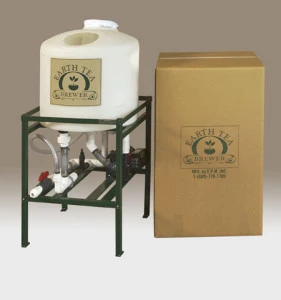 As gardeners begin to look for natural and organic ways to promote plant productivity and health, more are turning to compost tea. By now, everyone knows about the benefits of having and using a backyard compost pile, but, you can take that idea one step further. Transform nutrient rich compost from a solid, into a liquid form. According to the University of Connecticut’s College of Agriculture and Natural Resources, there is an equivalent amount of aerobic bacteria and fungi in a 5 gal batch of aerated tea a there is in about 40 cubic yards of regular compost. Powerful Stuff!
As gardeners begin to look for natural and organic ways to promote plant productivity and health, more are turning to compost tea. By now, everyone knows about the benefits of having and using a backyard compost pile, but, you can take that idea one step further. Transform nutrient rich compost from a solid, into a liquid form. According to the University of Connecticut’s College of Agriculture and Natural Resources, there is an equivalent amount of aerobic bacteria and fungi in a 5 gal batch of aerated tea a there is in about 40 cubic yards of regular compost. Powerful Stuff!
Understand that this is not simply a shovel full of compost placed in a bucket adding water and letting the mix step for a couple days. Although, this is not a bad idea, it is merely a watery compost extract. Compost tea is actually brewed under conditions referred to as “actively aerated compost tea” (AACT). When this brewed compost tea is added to plants, it can boost overall plant heath, and can be more able to resist pests and disease.
How is compost tea made? Here at Beautiful Blooms, we have a 25 gallon tea brewer made specifically for this purpose. Here is the basic idea: First, the compost is placed in a large, fine meshed “tea bag”. Next, the tea gets aerated, as well as mixed and stirred at the same time. (Remember, the tea can only be as...
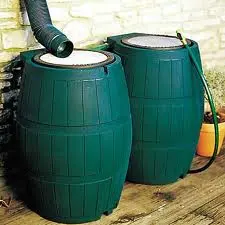 This past Saturday, (Oct. 12th), I listened to what was probably the last thunderstorm of the season. Along with some pretty gusty winds was a very heavy rainfall, which I watched roll down the streets towards drains that were already covered with leaf debris. All that water running into our sewers and eventually out to Lake Michigan, not just waste water but wasted water. How many times a year do we hear about MMSD (Milwaukee Metropolitan Sewage District) having to dump the contents of the storm sewers into lake Michigan UNPROCESSED because of a heavy downpour that the sewer system couldn’t handle? There is a solution, and an easy one. Install a rain barrel in our yard capturing the roof fun off from your house and/or garage. This will not only help preserve Lake Michigan, but reduce water pollution (oil, grease, fertilizers) and can also lower your water costs.
This past Saturday, (Oct. 12th), I listened to what was probably the last thunderstorm of the season. Along with some pretty gusty winds was a very heavy rainfall, which I watched roll down the streets towards drains that were already covered with leaf debris. All that water running into our sewers and eventually out to Lake Michigan, not just waste water but wasted water. How many times a year do we hear about MMSD (Milwaukee Metropolitan Sewage District) having to dump the contents of the storm sewers into lake Michigan UNPROCESSED because of a heavy downpour that the sewer system couldn’t handle? There is a solution, and an easy one. Install a rain barrel in our yard capturing the roof fun off from your house and/or garage. This will not only help preserve Lake Michigan, but reduce water pollution (oil, grease, fertilizers) and can also lower your water costs.
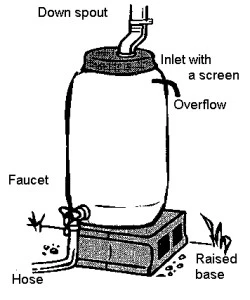 According to the Environmental Protection Agency, outdoor irrigation can count for up to 40% of water use by households during the summer when rain becomes scarce. Municipalities often institute mandatory water restrictions, leaving your yard and plants brown and crispy, sometimes with the negative effects lasting into the next summer. Just one rain barrel can save the average home owner up to 1300 gallons of water during the summer. With the usual rain barrel being a 55 gallon drum, just ¼ inch of rain can fill it to the top and can be used...
According to the Environmental Protection Agency, outdoor irrigation can count for up to 40% of water use by households during the summer when rain becomes scarce. Municipalities often institute mandatory water restrictions, leaving your yard and plants brown and crispy, sometimes with the negative effects lasting into the next summer. Just one rain barrel can save the average home owner up to 1300 gallons of water during the summer. With the usual rain barrel being a 55 gallon drum, just ¼ inch of rain can fill it to the top and can be used...
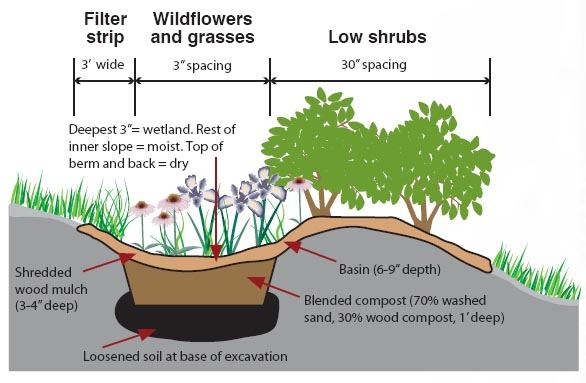 In a previous blog article, I wrote about using a rain barrel in your yard to save money for the homeowner and to help save local lakes and streams from storm run-off. As a new homeowner, one of my first purchases next spring will be a rain barrel. But there is another way to capture that storm run-off and beautify your yard at the same time- A rain garden. Like rain barrels, rain gardens have gotten a lot of press recently, but many homeowners still seem confused or reluctant to install one. What exactly is a rain garden? How does it work? What kind of plants do I install? Hopefully, this blog can answer questions and clear up some of the confusion.
In a previous blog article, I wrote about using a rain barrel in your yard to save money for the homeowner and to help save local lakes and streams from storm run-off. As a new homeowner, one of my first purchases next spring will be a rain barrel. But there is another way to capture that storm run-off and beautify your yard at the same time- A rain garden. Like rain barrels, rain gardens have gotten a lot of press recently, but many homeowners still seem confused or reluctant to install one. What exactly is a rain garden? How does it work? What kind of plants do I install? Hopefully, this blog can answer questions and clear up some of the confusion.
First, what exactly is a rain garden? In the simplest terms, a rain garden is a shallow depression in your yard, planted with native plants. These depressions are often, through not always mulched. The plants are planted in soil that has been amended to increase its filtration rate. A fancy way of saying, how fast the water absorbs into the ground. When choosing a site for you rain garden, consider an area in which storm water run-off is most prevalent in your property. Remember that downspouts can be directed into rain gardens to absorb run-off from buildings. Avoid placing rain gardens on a slope (it may actually encourage erosion), directly above septic systems, and remember to keep your rain garden a minimum of 10 feet away from the...
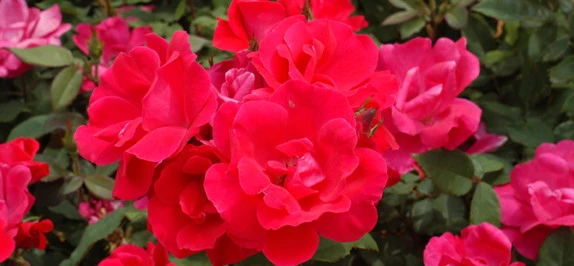 The knockout rose is a popular plant in many people’s landscapes and with good reason. Introduced in the year 2000 and winner of numerous awards, including rose of the year from the American Rose Society, it is the most widely sold rose in North America. Over the past couple of landscape seasons, our customers have had questions about, or simply did not understand all the benefits of these great roses. Here is a little “rose primer”, if you will, about the knockout rose.
The knockout rose is a popular plant in many people’s landscapes and with good reason. Introduced in the year 2000 and winner of numerous awards, including rose of the year from the American Rose Society, it is the most widely sold rose in North America. Over the past couple of landscape seasons, our customers have had questions about, or simply did not understand all the benefits of these great roses. Here is a little “rose primer”, if you will, about the knockout rose.
The rose was created by Wisconsin rose breeder, William Radler, who was looking to reduce the “to do list” in rose gardens. It is a cold hardy, disease resistant, and self cleaning; meaning, there is no need to deadhead.
That’s right, I said, NO NEED TO DEADHEAD! True pruning (trimming or cutting off parts of the plant that are superfluous, or to improve the shape or growth), should really only be done about once a year. The knockout website as well as other experts agree, the time to prune is late winter to early spring (after the last hard frost, but before new growth appears). Do not prune in the fall. When pruning, remove and dead or damaged wood, and do little shaping if necessary. Knockouts are designed to grow vigorously, so prune them down to about 2-2 ½’ below the height you would like them to be. According to the knockout website, these roses are...
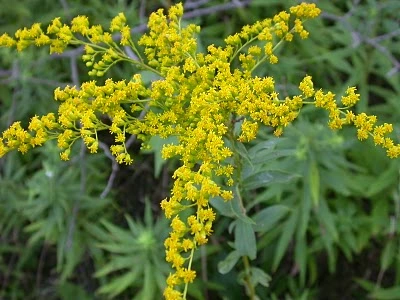 It is mid-September. Are your eyes itchy? Is your nose runny? Do you sneeze worse when you step outside? Chances are, you are suffering from hay fever and the culprit is ragweed- NOT Goldenrod. Goldenrod – that tall late summer/early fall blooming perennial with yellow flowers- often is unfairly blamed for causing hay fever. That’s too bad, because goldenrod is a wonderful addition to the back of any perennial border. So, why does goldenrod get such a bad rep? Well, both ragweed and goldenrod bloom at the same time, and when people see the masses of bright golden flowers, they automatically assume that its pollen is the source of their irritations. Actually, goldenrod pollen is too heavy and sticky to be blown far from the flowers, which is why it is so brightly colored. Goldenrod must need a way to attract insects who are its main pollinators.
It is mid-September. Are your eyes itchy? Is your nose runny? Do you sneeze worse when you step outside? Chances are, you are suffering from hay fever and the culprit is ragweed- NOT Goldenrod. Goldenrod – that tall late summer/early fall blooming perennial with yellow flowers- often is unfairly blamed for causing hay fever. That’s too bad, because goldenrod is a wonderful addition to the back of any perennial border. So, why does goldenrod get such a bad rep? Well, both ragweed and goldenrod bloom at the same time, and when people see the masses of bright golden flowers, they automatically assume that its pollen is the source of their irritations. Actually, goldenrod pollen is too heavy and sticky to be blown far from the flowers, which is why it is so brightly colored. Goldenrod must need a way to attract insects who are its main pollinators.
Ragweed has small, fairly unremarkable flowers that unleash abundant amounts of pollen freely into the wind. The only way you and I know that ragweed is blooming at all is through our allergic reactions to the pollen. Thousands of tiny flowers on each plant result in the release of approximately one billion grains of pollen. This happens usually during the mid-morning hours as dew dries and humidity decrease. It is estimated that up to 1 million tons of ragweed pollen is produced each year in North America...
 It is time to think about your landscape management needs for the coming fall season and next year. In just a few short weeks, we will begin fall cleanup activities! Cleaning up the garden in the fall is an important part of the overall maintenance of your landscape and should not be overlooked. On the other hand, if taking a drive to enjoy the fall color and inviting friends over to watch the football game is how you would rather enjoy the fall season then call Beautiful Blooms now! We are ready to take care of all of your lawn and garden clean-up chores. As you already know, we provide quality service at a reasonable price. We are happy to work with you to tailor a program that suits your needs and your budget.
It is time to think about your landscape management needs for the coming fall season and next year. In just a few short weeks, we will begin fall cleanup activities! Cleaning up the garden in the fall is an important part of the overall maintenance of your landscape and should not be overlooked. On the other hand, if taking a drive to enjoy the fall color and inviting friends over to watch the football game is how you would rather enjoy the fall season then call Beautiful Blooms now! We are ready to take care of all of your lawn and garden clean-up chores. As you already know, we provide quality service at a reasonable price. We are happy to work with you to tailor a program that suits your needs and your budget.
Listed below is an informational update and summary of all the services offered by Beautiful Blooms. Please look it over and indicate if you are interested in any additional services for this fall or the coming 2014 season. Our schedule fills up quickly so if you are interested in 2013 Fall Services, your earliest response will allow us to offer you the best possible service.
Curbside Leaf Pickup
 Do you need your leaves hauled to the city compost pile, but don’t really want to spend every spare moment you have this fall filling and cramming all those little bags into the back of the family car? Let us come and take them away for you. We use a high powered debris vacuum system to shred...
Do you need your leaves hauled to the city compost pile, but don’t really want to spend every spare moment you have this fall filling and cramming all those little bags into the back of the family car? Let us come and take them away for you. We use a high powered debris vacuum system to shred...
 Did you know that since 2009, Beautiful Blooms has been using OMRI approved organic pesticides to care for plants in your landscape and since the spring of 2012 the only synthetic pesticide we use in the care of your landscape perennials and shrub beds is Roundup®? It’s true!
Did you know that since 2009, Beautiful Blooms has been using OMRI approved organic pesticides to care for plants in your landscape and since the spring of 2012 the only synthetic pesticide we use in the care of your landscape perennials and shrub beds is Roundup®? It’s true!
In early spring of 2012, I took our inventory of synthetic pesticides to the local hazardous waste processing facility and we have not looked back since. I have to say…it felt really good to do that, that day.
In June of 2013 we used up our last bag of synthetic fertilizer for landscape beds and when Mary Beth asked if she should order more I said “Nope, we’ve got that covered with organics now”. What I was referring to was using compost tea with various organic additives. We have a compost tea brewer and we brew 20-80 gallons of tea per week for use on all of the properties we care for. The results are tremendous. We see an improved perennial in just a few days or weeks, shrubs react a little more slowly and typically show their improved health the following year after applications have begun. Remember—compost tea is a soil treatment and healing our soils after years/decades of degradation through the use of conventional chemical use take a little bit of time.
At this time, the only synthetic pesticides that we use in the care for ANY landscape is for the treatment of pests or diseases on trees and broad leaf...
Congratulations! You have just made a significant investment to your yard, and to your life, by installing new plant material. To ensure that investment is productive and successful, you need to nurture it, just like any other investment, making sure you do all you can to help it pay-off. So, now what?
Watering – not enough or too much – is the most important step in establishing new plants. Beautiful Blooms will always “water-in” all the plant material they install for you. However, once we leave the property, you become responsible for seeing that adequate moisture is supplied. Knowing when and how much to water – and conversely, when not to water – can be tricky, so we offer these guidelines.
Perennials: It is recommended that you water 3 times-a-week, for the first 3 weeks whether is rains or not. After 3 weeks, water once-a-week, unless there is at least ½ inch of rainfall during that week. If natural rainfall is not sufficient, then supplemental, regular watering is needed. Remember that plants dry out faster in windy, unprotected areas, as well as on slopes. Also, pay close attention to plants placed under a roof overhang; they will need slightly more water since the soil in that area tends to be drier as it does not receive any rain.
Small shrubs: You should use a hose at a slow trickle for 10-20 minutes per shrub to thoroughly saturate the root zone. You will want to keep the water at the ...
Fall: My Favorite Season & Great Grass Growing Weather
—Mike Harrington
Fall is my favorite time of the entire year. Cooler nights and decreasing daytime temperatures are a big factor in my enjoyment of this season. I love being outside on fall evenings because you can feel the temperature changes every night. Rainfall events also happen more frequently during the fall as compared to the normal July and August weather and I thoroughly enjoy storms. Turf-grass has been a passion for me for over 2 decades now. I am not sure it is fair to compare myself to turf-grass as kindred spirits, but just as I love the weather and the season, so does turf-grass.
The heat and humidity have dropped allowing turf-grass to thrive in cooler temperatures. The rainfall helps to keep the grass growing and it definitely aids in germination of any new seed that has been planted. These conditions make the fall the best time of year to try and repair a lawn that has been damaged from neglect, overuse, or just summer stress. The first step in lawn repair and recovery is aeration.
Aeration is best performed in the fall because it helps stressed turf to recover from the summer’s heat and humidity. It opens up the soil allowing better nutrient and moisture uptake. Aeration relieves compaction that forms from use of the lawn. It also helps to relieve the hardpan areas that might develop from the long periods of time with a lack of moisture. Not only does aeration benefit the...
Is your lawn chemical dependent? For over half a century, the normal and accepted way to maintain a home lawn was to apply fertilizer, pesticides, water, and regularly mow it….and collect the clippings of course. In the past decade this mantra has been evolving.
Two items on this list seem to be easily understood and adapted by the majority of the public.
First to go was collecting your clippings.
This seemed to be perhaps the most painless step in converting the general public to a more earth friendly way of caring for their lawn—in part because the municipalities stopped collecting most green waste.
Depending on the part of the country you live in, watering restrictions can be severe. Here in Wisconsin we typically only see restrictions during extended periods with little to no rain. Even these restrictions are quite mild—usually every other day watering is allowed. Compare that with west Texas where outdoor watering is limited to 2 hours per MONTH.
Maintaining a tightly manicured lawn requires a lot of inputs. Can we have our cake and eat it too? That is really the question. Most people are not willing to give up all of their lawn space, and it is justifiably useful to a degree. If you have pets, children, or simply enjoy being outside in your yard lawn is a necessary part of your landscape. To decrease the amount of synthetic fertilizer and pesticides applied to your...
Just complete the form below to get a pricing quote.
